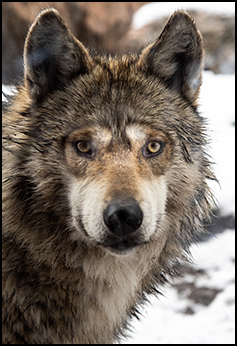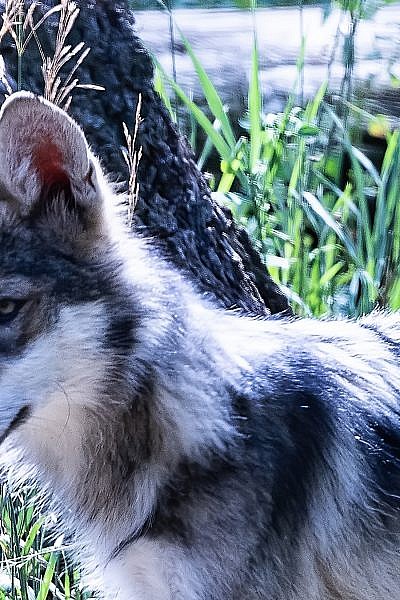Cheyenne Mountain Zoo is home to a pack of seven Mexican wolves, and we support the restoration of a similar species – the gray wolf – to our state’s wild places on the Western Slope. Cheyenne Mountain Zoo has a long history of working to restore and relocate species, including black-footed ferrets, Wyoming toads, Mexican wolves, giraffe in Uganda, amphibians in Panama, and more. As an organization that contributes to the survival of species around the world, this is an exciting chance for Colorado residents to help restore a species that once roamed free, right here at home.
“We support restoring the natural balance by helping wild animal populations return to protected wild places,” said Dr. Liza Dadone, vice president of mission and programs at Cheyenne Mountain Zoo. “We see our role in this issue as trusted wolf experts and animal advocates. We want to help by addressing common misconceptions about wolves, based on our extensive experiences with them. We also feel compelled to raise awareness of this petition, so our community has the information needed, so Coloradoans can decide if reintroduction of wolves is right for our state.”
The Rocky Mountain Wolf Project is currently leading the way on collecting signatures on petitions throughout the state, with hopes to bring this issue to a public vote for the November 2020 general election. The petition is actively underway until Dec. 8, 2019.
As part of Cheyenne Mountain Zoo’s effort to educate the public about the ecological benefits of these once-thriving Colorado animals, Rocky Mountain Wolf Project’s beautiful and informative art exhibit, “Living with Wolves,” is on display at Primate World through November 2019. The art display helps dispel myths about the dangers of wolves.

A common concern about the reintroduction of wolves to Colorado is about the safety of people who might encounter a wolf while enjoying time in nature. Unlike mountain lions and other predators found in wild and populated areas throughout Colorado, a wolf’s natural reaction to human presence is to retreat.
“Due to inaccurate portrayals of wolves in movies and other popular culture, some people may not know that wolves instinctively avoid human contact,” said Dadone. “When our keepers go into the enclosure with our pack of Mexican wolves to clean and replenish food, water and enrichment items, the wolves typically get as far away from them as possible. It’s a natural instinct that we like to see, as the hope for our wolves is that their offspring are one day restored to the wild to support their dwindling wild population.”
The Rocky Mountain Wolf Project reports that since 1900, there have been only two possible cases of a wolf-related human fatality in North America, and no cases in the lower 48 states.
This is a complex issue, especially for farmers and ranchers in the regions proposed for reintroduction. As caretakers of animals, we understand that farmers and ranchers care for their animals and have invested generations of energy into them. We also know that both compensation for their livestock and mitigation strategies are essential if wolves are restored to Colorado. We encourage these open conversations, as we hope they will lead to solutions that benefit wildlife, wild places, and the people who live near them.
There is evidence of wolves’ positive impact on restoring balance in struggling ecosystems, too. Some may be familiar with the reintroduction of wolves to Yellowstone National Park, in 1995. The National Park’s elk population had grown to levels not healthy for the ecosystem, due to the absence of predators, like the wolf. The elk drastically reduced the number of trees and shrubs that prevent erosion and serve the rest of the ecosystem.
Birds lost habitats, as a result of the fauna’s inability to grow to maturity. The water temperature in streams rose, due to a lack of shade from trees and shrubs, which made them uninhabitable for fish and other aquatic species. Without competition from wolves, coyote populations increased, which reduced the number of small mammals in the area that served as a food source for many smaller predators, like foxes.
Since reintroducing the wolf, Yellowstone National Park’s elk population has decreased and become healthier. The wolves single out the weak, old, sick and young elk, leaving the strongest elk to reproduce and carry on healthy genetic lines. The Rocky Mountain Wolf Project also says the wolves’ presence near waterways reduced the negative impact elk had on streams, trees and shrubs and the animals that live there, simply by redirecting the elk. Coyote numbers have decreased, creating a better balance and more available food sources for foxes, badgers, weasels and raptors, which share their prey.
Until the 1940s, when wolves were eradicated from Colorado’s wild places, wolves thrived in the Rocky Mountain State. The last wolf was shot in 1945, as a result of an extermination campaign that didn’t consider the wolves’ important role in our delicate mountain ecosystem. While an occasional “lone wolf” has migrated into our state, wolves have not been able to establish a population in our state in over 70 years.
As an apex predator, their presence at the top of the food chain in Colorado is vital, as it is in Yellowstone National Park. Western Colorado, where the Rocky Mountain Wolf Project seeks to reintroduce wolves, has more than 15 million acres of public land with an abundance of wild prey for hunters and wolves.
Guests can stop by Wolf Woods to sign the petition, and visit the art exhibit at Primate World to learn more about the incredible gray wolf and the positive impacts its presence could make on our state. There are also Rocky Mountain Wolf Project representatives throughout Colorado, who are collecting signatures. Look out for the Rocky Mountain Wolf Project logo and a person with a clipboard to share your opinion or to support the effort to bring this issue to a public vote.

